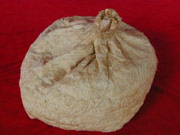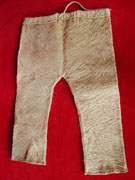 |
|
A Jacket Made from Upas Bark (Antiaris
toxicaria) |
|
 |
|
A Cap Made from the Upas Bark |
Before human beings learnt to weave cloth, people wore leaves and hides to shelter coldness. An ancient Dai ballad says:
"in ancient times, people wear hides". However, it would be very difficult to discover when the minorities in Xishuangbanna got rid of leaves and hides. The story goes: Zhuge Liang (one of the most famous oracles in ancient China) arrived at South of Yunnan. The Dai folks told him that they could not weave; Zhuge Liang cut off his sleeves and let them weave and cut cloth according to his sleeves. From then on, the Dai folks learnt to make their tight skirts. Until today, some minorities in the mountain areas of Xishuangbanna still use barks to process their sleeping pads. The tree is upas . which is quite poisonous. The bark of the tree has a thick layer of fibers. The people cut the trunk of the tree into certain lengths according to their needs, then, they skin the barks off completely through knocking; after that, they hammer and wash the barks repeatedly, so that the liquids of the tree and other poisonous substances could be washed away. Finally, they would get a white and soft sleeping pad, which is warm and moistureproof. When they go out for hunting, they often take such pads with them, because the pad could be used as both the quilt and the sleeping pad. It is said that this kind of fiber once was used to make tight skirt and clothes.
 |
|
Trousers Made from
Upas Bark |
In the documents of the Han Chinese, we could often read descriptions about the ancestors of the Dai people, and the most famous stories in inland about them have relations with upas cloth. In
"Stories of Minorities in Southwest" in a book named "the Historical Records of the Later Han
Dynasty"; it was recorded that: "there is a kind of cloth, its textures are like that of silk; it is made out of a kind of tung tree. The width of the cloth is 5 feet, and the cloth is quite
white". What is tung tree then? According to our investigation, it is a kind of
Bombaxceiba growing in the rain forest. Afterwards, all the minorities in Xishuangbanna learnt to weave cloth and to breed silkworms, and they stopped to wear clothes made of leaves and hides. In modern times, the minorities of Xishuangbanna learnt to make use of some other plants, such as
Bombaxceiba and Saccharum arundinaceum, to make pillows and pads; which are quite comfortable. Some Dai folks still plant
Bombaxceiba and Saccharum arundinaceum on the hills.
 
|

